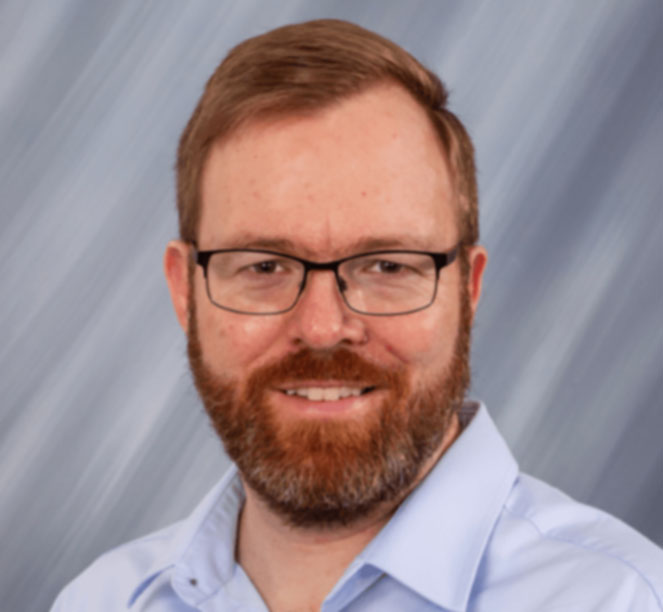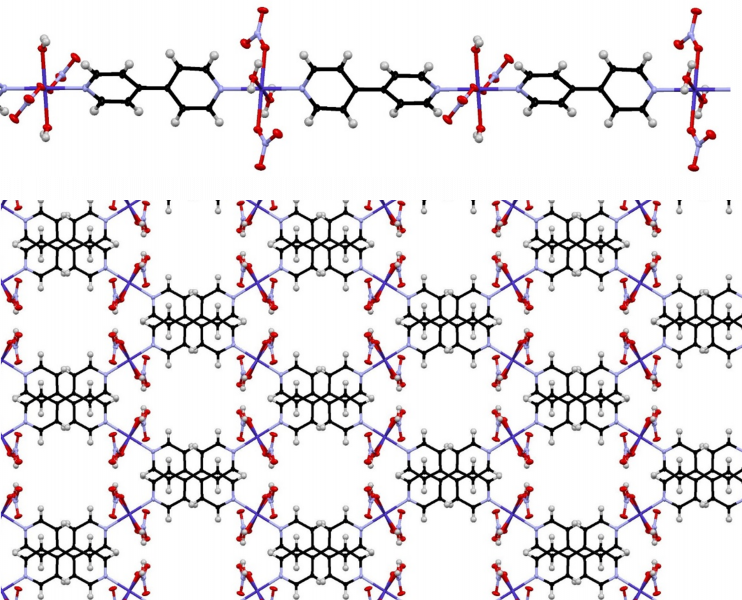Colin Weeks
Associate Professor - Inorganic Materials

291 McCollum Science Hall
Directory Contact
Colin Weeks
Associate Professor - Inorganic Materials
Dr. Weeks is interested in inorganic chemistry and in materials chemistry. His current research focuses on synthesizing and investigating the properties of metal-organic framework materials.

A 1D chain metal-organic polymer that forms crystals with 4 Å pores.
Metal-organic framework materials are constructed by using organic ligands to bridge multiple metal centers and form crystalline one-dimensional (1D) chains as well as 2D and 3D frameworks.
These materials are exciting because the many bridging ligands and metal coordination geometries available make it possible to produce a vast array of framework structures, and to design them with interesting properties such as microporosity and magnetism.
Dr. Weeks lab studies porous metal-organic frameworks that are able to reversibly adsorb guest molecules in their pores, which are typically in the micropore size range (<20 Å). Porous frameworks have potential applications in molecular separations, as molecular sensors and as catalysts. Characterizing the sorption properties of metal-organic frameworks, especially in the liquid phase, and understanding the factors that control it are necessary for such applications to become reality, and are a major focus of his research. Other interesting properties, such as magnetism, can also be affected by the molecules adsorbed in the pores of metal-organic frameworks.
Dr. Weeks is also interested in the mechanisms by which crystals of metal-organic frameworks form. While choice of metal center and bridging ligand(s) provide a certain degree of control over the structure, other factors such as the solvent mixture used to grow the crystals and template molecules that occupy the pores also have large effects. One goal of his research is to identify the intermediate species involved in the growth of metal-organic framework crystals and to use this information to control framework structure and make their synthesis more efficient.
1997 B.Sc.(Hons.), University of Sydney
2001 Ph.D., University of Sydney
MOF crystal growth: UV resonance Raman investigation of metal-ligand binding in solution and accelerated crystal growth methods
Thomas D. Petersen, Gurusamy Balakrishnan, Colin L. Weeks* (2015) Dalton Transactions, 44, 12824-12831, DOI: 10.1039/c5dt01588j.
Analytical investigation of urea deposits in SCR system
Colin L. Weeks*, Dan Ibeling, Sonia Han, Lindsey Ludwig, Ayyappan Ponnaiyan* (2015) SAE International Journal of Engines, 8, 1219-1239, DOI: 10.4271/2015-01-1037.
EXAFS and EPR studies of the alkene oxidation catalyst species, trans-[CrIII(bpb)(L)2]n+ and Cr(V) oxidation products (bpb = N,N¢-bis(2-pyridinecarboxamido)-1,2-benzene)
Colin L. Weeks, Aviva Levina, Ronald R. Fenton, Peter A. Lay* (2015) Australian Journal of Chemistry, 68, 581-592, DOI: 10.1071/CH14532.
Structure control and sorption properties of porous coordination polymers prepared from M(NO3)2 and 4,4'-bipyridine (M = Co2+, Ni2+)
Kathryn Mauger-Sonnek, Laura K. Streicher, Owen P. Lamp, Arkady Ellern, Colin L. Weeks* (2014) Inorganica Chimica Acta, 418, 73-83, DOI: 10.1016/j.ica.2014.04.025.
Cysteine-linked aromatic nitriles as UV resonance Raman probes of protein structure
Colin L. Weeks, Hyunil Jo, Brandon Kier, William F. DeGrado, Thomas G. Spiro* (2012) Journal of Raman Spectroscopy, 43, 1244-1249, DOI: 10.1002/jrs.3167.
Reversible heme-dependent regulation of human cystathionine b-synthase by reductive carbonylation
Ömer Kabil, Colin L.Weeks, Sebastián Carballal, Carmen Gherasim, Beatriz Alvarez, Thomas G. Spiro, Ruma Banerjee* (2011) Biochemistry, 50, 8261-8263, DOI: 10.1021/bi201270q.
The molecular mechanism of Mo isotope fractionation during adsorption to birnessite
Laura E. Wasylenki*, Colin L. Weeks, John R. Bargar, Thomas G. Spiro, James R. Hein, Ariel D. Anbar (2011) Geochimica et Cosmochimica Acta, 75, 5019-5031, DOI: 10.1016/j.gca.2011.06.020.
